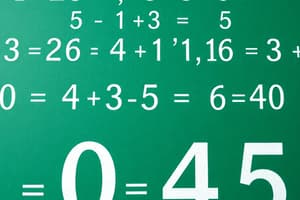Podcast
Questions and Answers
The identity property of addition states that $a + 1 = a$.
The identity property of addition states that $a + 1 = a$.
False (B)
The zero property of multiplication states that any number multiplied by zero equals zero.
The zero property of multiplication states that any number multiplied by zero equals zero.
True (A)
Subtraction is a commutative operation.
Subtraction is a commutative operation.
False (B)
Division by zero is defined and equals zero.
Division by zero is defined and equals zero.
In a proper fraction, the numerator is greater than the denominator.
In a proper fraction, the numerator is greater than the denominator.
The operation $3/4 ÷ 1/2$ results in $3/2$.
The operation $3/4 ÷ 1/2$ results in $3/2$.
The associative property of multiplication indicates that $(a × b) × c = a × (b × c)$.
The associative property of multiplication indicates that $(a × b) × c = a × (b × c)$.
To add or subtract fractions, having the same numerator is sufficient.
To add or subtract fractions, having the same numerator is sufficient.
The statement $a + (-b) = a - b$ is always true.
The statement $a + (-b) = a - b$ is always true.
Flashcards are hidden until you start studying
Study Notes
Basic Mathematics Study Notes
Addition
- Definition: Combining two or more numbers to get a total.
- Symbols: + (plus)
- Properties:
- Commutative: a + b = b + a
- Associative: (a + b) + c = a + (b + c)
- Identity: a + 0 = a
Subtraction
- Definition: Finding the difference between two numbers.
- Symbols: - (minus)
- Properties:
- Not commutative: a - b ≠ b - a
- Identity: a - 0 = a
- Inverse of addition: a - b = a + (-b)
Multiplication
- Definition: Repeated addition of a number a specified number of times.
- Symbols: × (times) or * (asterisk)
- Properties:
- Commutative: a × b = b × a
- Associative: (a × b) × c = a × (b × c)
- Identity: a × 1 = a
- Zero property: a × 0 = 0
Division
- Definition: Splitting a number into equal parts or groups.
- Symbols: ÷ (divided by) or / (slash)
- Properties:
- Not commutative: a ÷ b ≠ b ÷ a
- Identity: a ÷ 1 = a
- Division by zero is undefined.
Fractions
- Definition: A way to represent a part of a whole, expressed as a/b where a is the numerator and b is the denominator.
- Types:
- Proper: numerator < denominator (e.g., 3/4)
- Improper: numerator ≥ denominator (e.g., 5/3)
- Mixed number: Combination of a whole number and a fraction (e.g., 1 1/2)
- Operations:
- Addition/Subtraction: Common denominator needed.
- Multiplication: a/b × c/d = (a × c)/(b × d)
- Division: a/b ÷ c/d = (a × d)/(b × c) (multiply by the reciprocal).
Addition
- Combines two or more numbers to yield a total, represented by the symbol + (plus).
- Commutative property allows rearrangement: a + b = b + a.
- Associative property permits grouping variations: (a + b) + c = a + (b + c).
- Identity property indicates adding zero: a + 0 = a.
Subtraction
- Determines the difference between numbers using the symbol - (minus).
- Non-commutative property means order matters: a - b ≠ b - a.
- Identity property shows subtracting zero retains the number: a - 0 = a.
- Functions as the inverse of addition: a - b can be expressed as a + (-b).
Multiplication
- Represents repeated addition, denoted by symbols × (times) or * (asterisk).
- Commutative property allows for switching factors: a × b = b × a.
- Associative property gives flexibility in group multiplication: (a × b) × c = a × (b × c).
- Identity property confirms multiplying by one keeps the number the same: a × 1 = a.
- Zero property states multiplying any number by zero results in zero: a × 0 = 0.
Division
- Splits a number into equal parts or groups, shown by ÷ (divided by) or / (slash).
- Non-commutative property illustrates that order impacts results: a ÷ b ≠ b ÷ a.
- Identity property indicates dividing by one keeps the number unchanged: a ÷ 1 = a.
- Division by zero is undefined, meaning it cannot be performed.
Fractions
- Represents a part of a whole as a/b, where a is the numerator and b is the denominator.
- Types of fractions:
- Proper fractions have numerators smaller than denominators (e.g., 3/4).
- Improper fractions have numerators equal to or larger than denominators (e.g., 5/3).
- Mixed numbers combine a whole number with a fraction (e.g., 1 1/2).
- Operations with fractions:
- Addition/subtraction requires finding a common denominator.
- Multiplication follows the formula: a/b × c/d = (a × c)/(b × d).
- Division uses the reciprocal: a/b ÷ c/d = (a × d)/(b × c).
Studying That Suits You
Use AI to generate personalized quizzes and flashcards to suit your learning preferences.




